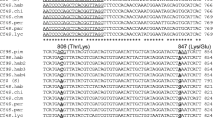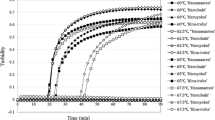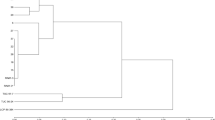Abstract
Insertion/deletion (InDel) markers are second most abundant polymerase chain reaction (PCR)-based molecular markers having enormous applications in genotyping and molecular breeding in different crops. Although standard polymerase chain reaction (PCR) for DNA amplification generally takes ~ 1.5 to 2 h, small amplicons can be effectively generated using dynamic heating and cooling through PCR with “V”-shaped thermal profile (VPCR) in ~ 15 to 20 min. Here, we evaluated the applicability of a partly modified VPCR method for amplifying InDels of tomato genome. Out of the 31 InDel markers tested in 15 diverse tomato genotypes, 29 markers resulted in sharp amplicons, where 26 markers were found to be polymorphic. Using this method, the individual DNA amplification reactions could be completed within ~ 30 min. The method was effective for primers varying in melting temperature (Tm) and GC contents. Furthermore, the need for empirically determining suitable annealing temperature could be bypassed using this generalised thermal profile. Through our results, we advocate the use of this method of DNA amplification in other plants to achieve rapid genotyping using standard molecular biology equipments and procedures.



Similar content being viewed by others
Data availability
All data generated in this research is incorporated in the manuscript and associated supplementary information.
References
Adedze YMN, Lu X, Xia Y, Sun Q, Nchongboh CG, Alam MA, Liu M, Yang X, Zhang W, Deng Z, Li W, Si L (2021) Agarose-resolvable InDel markers based on whole genome re-sequencing in cucumber. Sci Rep 11:3872. https://doi.org/10.1038/s41598-021-83313-x
Brody JR, Kern SE (2004) Sodium boric acid: a Tris-free, cooler conductive medium for DNA electrophoresis. Biotechniques 36(2):214–216. https://doi.org/10.2144/04362BM02
Chattopadhyay T (2014) In silico analysis of the germin like protein multigene family members of tomato with predicted oxalate oxidase activity. Int J Agric Environ Biotech 7:669–678. https://doi.org/10.5958/2230-732X.2014.01374.6
Chattopadhyay T, Biswas T, Chatterjee M, Mandal N, Bhattacharyya S (2008) Biochemical and SSR marker based characterization of some Bengal landraces of rice suffixed with ‘sail’ in their name. Indian J Genet Pl Br 68(1):15–20
Chen R, Lu X, Li M, Chen G, Deng Y, Du F, Dong J, Huang X, Cui X, Tang Z (2019) Polymerase chain reaction using “V” shape thermal cycling program. Theranostics 9(6):1572–1579. https://doi.org/10.7150/thno.31986
Chen R, Ding S, Wei Y, Yu J, Xu R, Luo X, Fan G, Yin H, Bian J (2021) Ultrafast identification of Pinelliae Rhizoma using colorimetric direct-VPCR. 3 Biotech 11:493. https://doi.org/10.1007/s13205-021-03035-9
Hazra P, Longjam M, Chattopadhyay A (2018) Stacking of mutant genes in the development of “purple tomato” rich in both lycopene and anthocyanin contents. Sci Hortic 239:253–258. https://doi.org/10.1016/j.scienta.2018.05.039
Hu W, Zhou T, Wang P, Wang B, Song J, Han Z, Chen L, Liu K, Xing Y (2020) Development of whole-genome agarose-resolvable LInDel markers in rice. Rice 13:1. https://doi.org/10.1186/s12284-019-0361-3
Jin L, Zhao L, Wang Y, Zhou R, Song L, Xu L, Cui X, Li R, Yu W, Zhao T (2019) Genetic diversity of 324 cultivated tomato germplasm resources using agronomic traits and InDel markers. Euphytica 215:69. https://doi.org/10.1007/s10681-019-2391-8
Kim B, Hwang IS, Lee H-J, Oh C-S (2017) Combination of newly developed SNP and InDel markers for genotyping the Cf-9 locus conferring disease resistance to leaf mold disease in the tomato. Mol Breed 37:59. https://doi.org/10.1007/s11032-017-0663-3
Kizil S, Basak M, Guden B, Tosun HS, Uzun B, Yol E (2020) Genome-wide discovery of InDel markers in sesame (Sesamum indicum L.) using ddRADSeq. Plants (Basel) 9(10):1262. https://doi.org/10.3390/plants9101262
Kumar P, Kumar V, Chattopadhyay T (2016) Gene cloning, recombinant expression and purification of a germin-like protein from tomato (Solanum lycopersicum L.). J Crop Improv 30(5):595–607. https://doi.org/10.1080/15427528.2016.1207122
Kumar V, Kumar P, Chattopadhyay T (2017) A rapid and reproducible method for isolating genomic DNA from a few crop plants suitable for polymerase chain reaction-based genotyping. J Appl Nat Sci 9(2):1119–1122. https://doi.org/10.31018/jans.v9i2.1332
Liu X, Geng X, Zhang H, Shen H, Yang W (2017) Association and genetic identification of loci for four fruit traits in tomato using InDel markers. Front Plant Sci 8:1269. https://doi.org/10.3389/fpls.2017.01269
Maurya D, Shree B, Akhtar S, Chattopadhyay T (2020) Exploring allelic status of selected disease resistance genes in a set of tomato genotypes using gene-linked molecular markers. J Crop Weed 16:236–241. https://doi.org/10.22271/09746315.2020.v16.i1.1299
Montgomery SB, Goode DL, Kvikstad E, Albers CA, Zhang ZD, Mu XJ, Ananda G, Howie B, Karczewski KJ, Smith KS, Anaya V, Richardson R, Davis J, The 1000 Genomes Project Consortium, MacArthur DG, Sidow A, Duret L, Gerstein M, Makova KD, Marchini J, McVean G, Lunter G (2013) The origin, evolution, and functional impact of short insertion-deletion variants identified in 179 human genomes. Genome Res 23(5):749–761. https://doi.org/10.1101/gr.148718.112
Păcurar DI, Păcurar ML, Street N, Bussell JD, Pop TI, Gutierrez L, Bellini C (2012) A collection of INDEL markers for map-based cloning in seven Arabidopsis accessions. J Exp Bot 63(7):2491–2501. https://doi.org/10.1093/jxb/err422
Phan NT, Kim M-K, Sim S-C (2016) Genetic variations of F1 tomato cultivars revealed by a core set of SSR and InDel markers. Sci Hortic 212:155–161. https://doi.org/10.1016/j.scienta.2016.09.043
Wu D-H, Wu H-P, Wang C-S, Tseng H-Y, Hwu K-K (2013) Genome-wide InDel marker system for application in rice breeding and mapping studies. Euphytica 192:131–143. https://doi.org/10.1007/s10681-013-0925-z
Yang J, Wang Y, Shen H, Yang W (2014) In silico identification and experimental validation of insertion-deletion polymorphisms in tomato genome. DNA Res 21(4):429–438. https://doi.org/10.1093/dnares/dsu008
Zeng YX, Wen ZH, Ma LY, Ji ZJ, Li XM, Yang CD (2013) Development of 1047 insertion-deletion markers for rice genetic studies and breeding. Genet Mol Res 12(4):5226–5235. https://doi.org/10.4238/2013.October.30.7
Acknowledgements
We thank Prof. Pranab Hazra, BCKV for providing seeds of “purple tomato” genotype. ICAR-IIHR, Bengaluru, ICAR-IIVR Varanasi and NBPGR, India are acknowledged for providing other seed materials. The authors thank Arnab Mukherjee and Deepsikha Kumari for their help. Financial support from BAU in terms of project grant (Code: SNP/CI/Rabi/2018-5) is highly acknowledged. This article bears BAU COMMUNICATION NO.1189/220603.
Funding
This research is funded by the project code: SNP/CI/Rabi/2018-5.
Author information
Authors and Affiliations
Contributions
TC conceived the idea. SS and TC performed the experiments. SA, TC and SS analysed the results. All the authors took part in preparation and correction of the manuscript. All the authors read the final manuscript and approved it.
Corresponding author
Ethics declarations
Conflict of interest
On behalf of all authors, the corresponding author states that there is no conflict of interest.
Research involving human participants and/or animals
No human participants and/or animals were involved in this study.
Informed consent
Not applicable as no human participants and/or animals were involved in this study.
Supplementary Information
Below is the link to the electronic supplementary material.
13205_2023_3499_MOESM2_ESM.tif
Supplementary Figure Sf1 VPCR to generate amplicons of different lengths using plasmid DNA as template. Inverse image of ethidium bromide stained 2.5 % (w/v) agarose gels showing efficiency of partly modified VPCR thermal profile in generating amplicons of different lengths using gene-specific primers and recombinant plasmid DNA as template. L = 100 bp DNA ladder (BioLit, SRL) (TIF 1637 KB)
13205_2023_3499_MOESM3_ESM.tif
Supplementary Figure Sf2 Failed and monomorphic InDel markers in 15 tomato lines using VPCR. Inverse image of ethidium bromide stained 2.5 % (w/v) agarose gels showing the 2 failed markers (sli2645 and sli2282) and monomorphic amplicons generated by 3 InDel markers (sli394, sli536 and sli572) in 15 tomato lines by the partly modified VPCR method. Lane 1 = H-86, 2 = BRDT-1, 3 = CLN B, 4 = CLN-1621-L, 5 = IIHR 2614, 6 = Kashi Chayan, 7 = VRTOLCV-16, 8 = VRTOLCV-32, 9 = H-88-78-1, 10 = VRKB-08, 11 = VRKB-09, 12 = VRKB-12, 13 = VRCYT-04, 14 = 2018/TOINDVAR-05 and 15 = Purple Tomato. L = 100 bp DNA ladder (BioLit, SRL) (TIF 3888 KB)
13205_2023_3499_MOESM4_ESM.tif
Supplementary Figure Sf3 Standard 3-step PCR using the failed InDel markers. Inverse image of ethidium bromide stained 2.5 % (w/v) agarose gels showing the amplicons generated by the 2 failed markers (sli2645 and sli2282) in 4 tomato lines by the standard 3-step PCR method. Lane 1 = H-86, 2 = BRDT-1, 3 = CLN B, 4 = CLN-1621-L. L = 100 bp DNA ladder (BioLit, SRL) (TIF 1522 KB)
13205_2023_3499_MOESM5_ESM.tif
Supplementary Figure Sf4 Dendrogram of 15 tomato genotypes generated on the basis of the polymorphism data generated by the 26 polymorphic InDel markers (TIF 1027 KB)
13205_2023_3499_MOESM6_ESM.tif
Supplementary Figure Sf5 Influence of cycle numbers and ramp rate on VPCR. A. Inverse image of ethidium bromide stained 2.5 % (w/v) agarose gels showing the amplicons generated by VPCR for 25, 30 and 35 cycles using 4 dilutions of genomic DNA isolated from the genotype H-86 by rapid method. B. Inverse image of ethidium bromide stained 2.5 % (w/v) agarose gels showing the amplicons generated by 35 cycle-VPCR in 75 % and 100 % ramp rate using 4 dilutions of genomic DNA isolated from the genotype H-86 by rapid method. C = crude sample; 2D = 2-fold diluted sample; 5D = 5-fold diluted sample; 10D = 10-fold diluted sample. L = 100 bp DNA ladder (BioLit, SRL) (TIF 1743 KB)
13205_2023_3499_MOESM7_ESM.tif
Supplementary Figure Sf6 Applicability of VPCR in genotyping of other crops. A. Inverse image of ethidium bromide stained 2.5 % (w/v) agarose gels showing the amplicons generated by SSR marker emf01J09 (Forward primer: 5´-ATAGCACCCACACTAAACCTTGGG-3´ and Reverse primer: 5´-GTTTCACTTCTTGGTCCATTGTTCAGA-3´) and emb01J19 (Forward primer: 5´-GACAGGGATAGGGGTACGGATAGG-3´ and Reverse primer: 5´-TACCATGTGATGCCTCGATTTTCT-3´) by VPCR using brinjal genomic DNA isolated by rapid method from 4 genotypes. Lane 1 = BRBR-06, 2 = Haritha, 3 = BRBL-02, 4 = BRBL-01. B. Inverse image of ethidium bromide stained 2.5 % (w/v) agarose gels showing the amplicons generated by SSR marker RM413 (Forward primer: 5´-GGCGATTCTTGGATGAAGAG-3´ and Reverse primer: 5´-TCCCCACCAATCTTGTCTTC-3´) using rice genomic DNA isolated by rapid method from 4 genotypes. Lane 1 = Sabour Surbhit, 2 = Rajendra Sweta, 3 = Sabour Deep, 4 = TN-01. L = 100 bp DNA ladder (BioLit, SRL) (TIF 1202 KB)
Rights and permissions
Springer Nature or its licensor (e.g. a society or other partner) holds exclusive rights to this article under a publishing agreement with the author(s) or other rightsholder(s); author self-archiving of the accepted manuscript version of this article is solely governed by the terms of such publishing agreement and applicable law.
About this article
Cite this article
Chattopadhyay, T., Sangam, S. & Akhtar, S. Rapid genotyping in tomato by VPCR using agarose gel-resolvable InDel markers. 3 Biotech 13, 85 (2023). https://doi.org/10.1007/s13205-023-03499-x
Received:
Accepted:
Published:
DOI: https://doi.org/10.1007/s13205-023-03499-x




